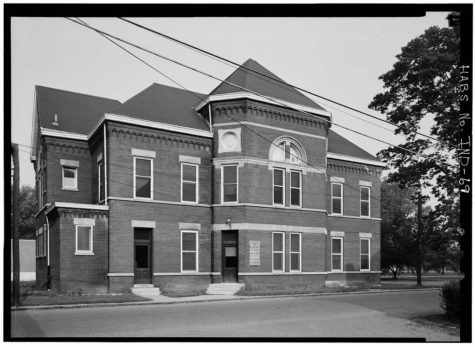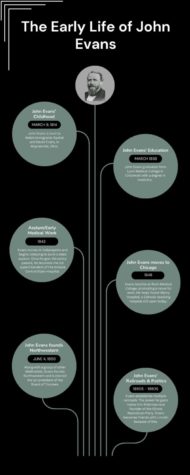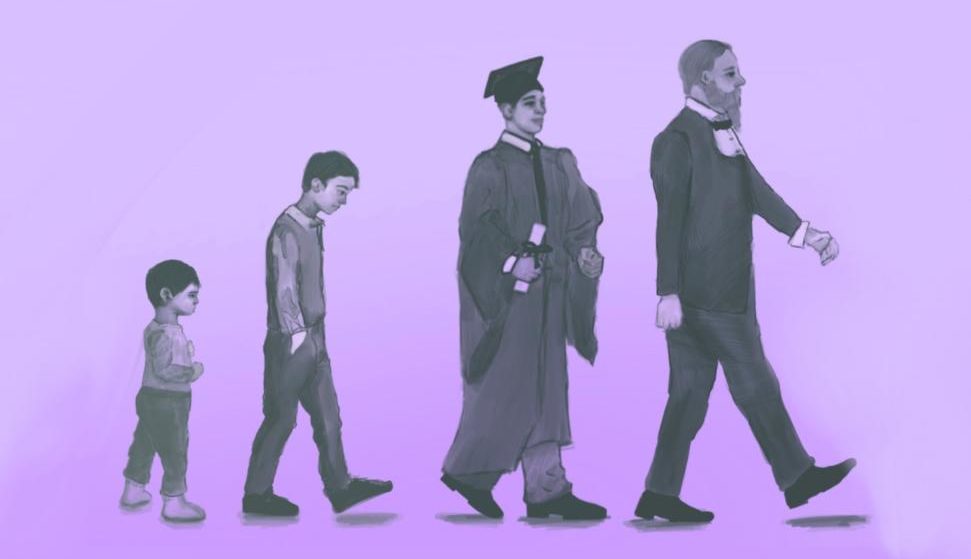Your donation will support the student journalists of the Evanstonian. We are planning a big trip to the Journalism Educators Association conference in Philadelphia in November 2023, and any support will go towards making that trip a reality. Contributions will appear as a charge from SNOSite. Donations are NOT tax-deductible.
Always craving more: Evans’ early life
Before the Sand Creek Massacre, Evans found success in the medical and political fields.
February 27, 2023
As John Evans lay dying in his Denver home on July 3, 1897, around 173 miles from the site of the Sand Creek Massacre, his life flashed before his weary eyes. Evans, the territorial governor of Colorado at the time of the massacre, had stated in prior interviews he bore no regrets for the tragedy that had resulted from his blinding enterprise. Born in Waynesville, Ohio, Evans had come a long way from home.
David Evans, John’s father, led a simple life compared to the one his son would go on to live.
A merchant in the small town of Waynesville, Evans and his wife, Rachel, were against the sale of liquor, both being decidedly religious Quakers. They professed values of integrity, peace and equality. These were values expected of their newly born son, John.
It was Mar. 9, 1814, when Evans came into the world inside a modest log cabin in Waynesville, located between Dayton and Cincinnati. He was the first of 11 children, although only nine made it past childhood—a survival rate that was quite high for the time compared to other families.
Part of the reason for the relatively low mortality rate could have been an output of the family’s economic position. In addition to running his store, David Evans worked as a real estate investor and a prosperous toolmaker. All of his work increased the Evans family’s financial status to be fairly well-off, and they could afford things that made John Evans’ early life much easier than many other children across the country. For example, his education was of a high standard, only available to upper-class white men at the time. His earlier school experience took place in and around Waynesville, after which he went to the Academy at Richmond, Ind., then Gwynedd Boarding School for Boys in Pennsylvania, ending his pre-college education at Clermont Academy near Philadelphia.
David Evans wanted John to follow in his footsteps and take over the successful businesses he cultivated over the years after John finished his secondary education. However, Evans, showing his ambition from a young age, felt destined for more than owning a small shop in a small town.
I am persuaded there was something more than this meant when I was made. I have long been of this notion, and for me, by irresolution, to thwart the design of my creation would be more wicked than a refusal to knuckle to any particular mode of getting along in the world.
— John Evans
“I am persuaded there was something more than this meant when I was made. I have long been of this notion, and for me, by irresolution, to thwart the design of my creation would be more wicked than a refusal to knuckle to any particular mode of getting along in the world, or any particular creed of faith,” wrote Evans in a letter to his cousin Benjamin on the subject of his schooling.
Evans’ pride was so great that he refused to accept any financial help from his father after they had decided he was to go to Lynn Medical College in Cincinnati. Evans, however, had no money. To attend school in 1836, he needed financial support from two practicing physicians in Waynesville. The two physicians agreed with Evans’ stance on not asking his family for money, and they were impressed by his vocation, so they covered the entire cost of his higher education.
Evans’ ambition presented itself throughout his college career as well.
“If you will not attribute it to vanity I will say I think I am about as devoted a student as we have in the college—my waking hours are almost wholly occupied in study, and I very frequently dream over whole demonstrations after hearing them in the day. So you see I think pretty well of my industry whatever others may say of it,” he said in a letter dated Nov. 13, 1837, and addressed to Hannah Canby, his future wife.
The obsessive mindset Evans took on in college would hurt him over the course of his life, but it served him well enough to get through university and graduate in two years, finishing medical school in 1838. Despite earlier reservations about the collegiate system, David Evans was so proud of his son that he presented John with a horse, saddle and ten dollars, equivalent to about $3,200 today. John Evans was married the same year and began his medicinal practice immediately after graduation.
Following his medical school education, Evans set out into the world to pursue medicine. After failed attempts to set up practice in Illinois and Ohio, he eventually landed in Attica, Ind, in 1839. He set up a medical practice with a man named Isaac Fisher, and together they found success. Evans was a staunch supporter of the efforts to build a state asylum and lobbied hard to make it happen. In 1843, he moved his family to Indianapolis so that he could continue his lobbying efforts and eventually succeeded. He was named the hospital’s first superintendent in 1845.

As part of his duties, he oversaw the construction of the facilities. He was careful to ensure that the institution would be run humanely and toured several similar hospitals to learn all he could. The construction was completed in 1848 and was named the Central Indiana Hospital for the Insane (later renamed the Central State Hospital) located in Indianapolis. At first, the institution served only five patients but expanded over time, serving patients from all over the state. Later on, as other psychiatric hospitals were established elsewhere in Indiana, Central State Hospital only served the middle counties of Indiana. In 1994, Central State Hospital closed its doors due to allegations of patient abuse and a lack of funding.
During this early stage of his career, Evans was offered a position at Rush Medical College in Chicago and accepted. For a few years, Evans balanced that job and his duties as superintendent of the psychiatric hospital in Indiana. He eventually quit his job in Indianapolis, committing completely to his work at Rush. He moved with his wife to Chicago in 1848, the same year the hospital finished construction.
Besides his interest in medicine, another pillar that guided Evans throughout his life was his devotion to Methodism. He did not grow up in a Methodist family. His parents were Quakers, and while Evans respected their religion, he chose a different path.
In 1841, Matthew Simpson, a Methodist Episcopal minister, came to Attica to preach. He was promoting the newly established Indiana Asbury University (now Depauw University), which had been created in 1837. Simpson had recently been named president of the university and was trying to bring attention to it while promoting his Methodist belief system. He was already well-established in the political and religious world and was on his way to becoming the Methodist Church’s most prominent bishop of the mid-nineteenth century. He had also been a close acquaintance of Lincoln, even delivering Evans’ eulogy. Simpson was trying to get more Methodists into prominent political positions, and as it turned out, Evans was the perfect man. In Attica, he preached at an old mill, and Evans was in attendance. The contents of the speech were not recorded, but that day changed Evans’ life forever.
Peter Hayes, a professor emeritus of history at Northwestern University and committee member of Northwestern’s John Evans report, describes Evans’ early experience with Simpson and Methodism.
“[Evans] talked about a sermon that he heard. This was before he got to Chicago. [He listened to Simpson,] and apparently, it was like an epiphany and from that moment on, he identified with the Methodist faith,” says Hayes.
As Evans put it, “He is the first man that ever made my head swim in talking. He carried his eloquence up to a climax, and I had to look around to see where I was.”
Instead of coming into his religion by family history, like most people do, Evans decided to become Methodist himself. After that evening, Evans and his wife became devoted Methodists. He remained good friends with Simpson until the bishop’s death in 1884.
As it turned out, Methodist beliefs at the time aligned perfectly with what Evans was starting to value in his career and the world. Simpson’s words already meant something to him, and his conversion to Methodism only reinforced his pre-established values.
“Simpson’s theology rested on the foundational traditions of Methodism, emphasizing that vigorous and constructive social engagement, when combined with conscientious self-discipline, was a form of religious practice,” writes the Northwestern report.
He is the first man that ever made my head swim in talking. He carried his eloquence up to a climax, and I had to look around to see where I was.
— John Evans on Methodist minister Matthew Simpson
This belief system convinced Evans that education was a priority and that it was his spiritual duty to continue the advancement of it, especially in towns that were relatively new back then. He thought that the character of an individual could be determined by his contributions to education. Later on, that conviction, along with his religious affiliations, would serve as a resource he used to establish one of the most prestigious universities in the modern world.
As the Northwestern report comments, it is important to note how Evans approached Methodism. Rather than partaking in the deeply thoughtful, reflective process that often accompanies many religious practices, he used a more pragmatic method. He dutifully participated in Methodism, which reflected his character as a whole; he was a very ambitious man who liked to get things done.
Part of Evans’ character was being an abolitionist. While he didn’t believe the federal government should go as far as some, such as future president Abraham Lincoln believed it should, in the years leading up to the Civil War, Evans believed that slavery should be abolished in D.C. as well as any federal territories. His abolitionist views weren’t uncommon in the North back then, and his religion contributed to that view.
“Evans was a very committed Methodist,” says Hayes. “In those days, what distinguished Methodism from other Protestant denominations is that they were world improvers; they were always trying to make the world in which they lived better than it had been before. I think that’s his route to ultimately supporting emancipation and opposing the expansion of slavery.”
As Hayes mentioned, the connection between Methodism and ‘world improvement’ would be a trend shown throughout the life of John Evans.
“His political ambitions were always connected to his desire to improve the world,” says Hayes.
When Evans moved to Chicago in 1848, after three years of balancing his job as superintendent of the first mental hospital in Indiana and being chair of obstetrics at Rush Medical College in Chicago, Chicago’s population was expanding rapidly. From 1850 to 1860, the population nearly quadrupled, going from 30,000 to 110,000. Chicago was viewed as a prosperous home for commerce, a rapidly-developing business hub located far from any ocean ports.
“Chicago was clearly going to be the kind of capital of, what was called in those days, the Northwest Territories,” says Hayes, referring to an area consisting of modern-day Ohio, Indiana, Michigan, Illinois and Wisconsin.
Evans thrived in Chicago, quickly gaining prominence in the Chicago medical community due to his work at Rush Medical College. He achieved further success by becoming the owner and editor of the Northwestern Medical and Surgical Journal, co-founding the Illinois General Hospital of the Lakes and establishing the Chicago Medical Society. During his time in Chicago, Evans also made advancements in medicinal practices. He invented a tool called an “obstetrical extractor,” which replaced the use of metal forceps in the field of obstetrics, and he published an article in 1849 revealing new information on Chicago’s then-ongoing cholera outbreak.
Even with all his success in the medical world, Evans craved more. Ambitious white men like Andrew Carnegie, John D. Rockefeller and Cornelius Vanderbilt seized on the various opportunities that came with America’s expansion, becoming immensely rich and powerful. Evans wanted more success of this nature for himself.
He dabbled in business during his time as a medical practitioner, purchasing the building at the site where today’s Chicago City Hall and Cook County Building are located, and as time went on, he directed his gaze more and more towards business.

In 1852, Evans sold his medical journal in exchange for five acres of land in Chicago, on which he helped orchestrate the construction of the Fort Wayne and Chicago Railroad. It was an investment that led Evans to become wealthy and further propelled him into business. Due to his wealth, Evans no longer needed to practice medicine, quitting the medical profession by the mid-1850s.
In 1850, Evans recognized Chicago’s growing importance in the country and realized the next step for the area was establishing a university. This led to one of his most well-known accomplishments, establishing Northwestern and its surrounding area, later known as Evanston.
“After Rush was established as a medical college, the next logical step would be to have a university, and Northwestern began as the university of the Northwest Territories,” says Hayes.
Evans and a committee of eight other prominent Chicago Methodists established Northwestern University in 1850. He made many contributions to the creation of the university, writing a draft of Northwestern’s charter, choosing the first president and—his biggest contribution—buying a farm north of Chicago on which Northwestern and the surrounding town would be built. Evans ascertained that the town would have contact with Chicago by ensuring the building of a rail line to connect the two. In 1854, after being elected chairman of the board of trustees, Evans’ fellow trustees decided to name the town Evanston in his honor.
Evans was crucial in Northwestern’s founding and remained on the Board of Trustees for years, even after he left Evanston. However, in the wake of Northwestern’s 2014 report on John Evans and his part in the Sand Creek Massacre, his role as founder of Northwestern is often downplayed. Nearly all reminders of the man who was largely responsible for Northwestern’s founding are gone, with only the John Evans Alumni Center remaining.
Despite professional success in medicine, Evans’ personal life was sorrowful. Three of his children passed young, with only his daughter Josephine surviving. In 1850, Hannah Canby, his wife, died of tuberculosis. Evans was a caring and committed husband, and Canby’s death was devastating.
“John Evans’s letters to both his wives reveal that he was a devoted suitor and loving husband who shared his most personal thoughts and feelings with them,” writes the Northwestern report.
Evans eventually overcame this loss and married Margaret Grey in 1853. Margaret was the sister of the wife of another Northwestern board of trustee member, and she and Evans had four children of their own. In 1855, when Northwestern opened its doors to students, he and his family moved to a new house in Evanston near the university campus. The house, which no longer stands, included gardens, gravel walkways and a barn.
Political power was another common aspiration among privileged white men of Evans’ time. Evans followed this trend, becoming an alderman of Chicago from 1853-1855. Evans provided many key developments in Chicago’s growth. He supported the construction of waterways, sewers, streets, sidewalks and alleys in the city. Values instilled in him by Methodist teachings also came into play during his time as an alderman. Education is an integral component of Methodism, and during his time as an alderman, Evans became a proponent of improving public education in Chicago. He was chair of the council’s committee on public schools, and during his time in this position, he made great strides forward. He increased the number of schools, united them, selected a superintendent and opened the first public high school in Chicago, aptly named Chicago High School.
However, not all of Evans’ political actions were for the benefit of others. Some were primarily for his own financial gain. One ordinance he introduced allowed the Fort Wayne and Chicago rail line to travel to the Indiana state border. Evans owned this rail line, and its increase in size deepened his pockets even further.
As the 1850s progressed, Evans only became more involved in politics. Previously a member of the Whig party, Evans transferred to the Republican Party in the mid-1850s due to the Whigs’ anti-slavery views. Around this time, Evans met fellow Illinois Republican Abraham Lincoln and became a supporter of his campaign.
He was typical of people who went out to the West. He was typical in the sense that he had the driving spirit that they were going to civilize the continent, and he was typical in his feelings [towards Native Americans]. They looked at the Native Americans and they saw nomads.
— Peter Hayes, committee member of the of the Northwestern John Evans report
Evans’ view on westward expansion fit his extremely ambitious personality. As a Methodist, he was interested in improving the world, but his intentions often lay in his own personal financial and political gain. As it turns out, that worldview was not uncommon for men of his status in those days.
“He was typical of people who went out to the West. He was typical in the sense that he had the driving spirit that they were going to civilize the continent, and he was typical in his feelings [towards Native Americans],” says Hayes. “They looked at the Native Americans and they saw nomads.”
For Evans, making productive use of the land involved building towns around railroads. This would ensure a steady flow of commerce throughout the developing West and would result in money in Evans’ pocket.
“He had a mentality that was based on agriculture, farming and developing cities that connected with railroads,” says Hayes. He continued, “[They thought the Native Americans] were not making the land produce wealth. The mentality of these people was that land was only good for producing wealth. They looked down on the Native Americans as unproductive, and their justification for taking the land from them was that they were going to make the soil more valuable.”
In 1857, Evans, along with other enterprising people of the time, attempted to establish a town called Oreapolis on the eastern border of the Nebraska Territory. Oreapolis would be similar to Evanston, with a university, a Bible institute and a Methodist seminary. The town aspired to be a hub of railroad activity, one of many hopeful railroad centers established across America. Wealthy entrepreneurs such as Evans founded towns like these in hopes of attaining even more wealth.
As the Northwestern report writes, “Oreapolis was one of the era’s countless would-be railroad centers that were conceived by speculators hoping to cash in on the lure of the West to settlers, prospectors, and other businessmen and investors.”
Ultimately, Oreapolis ended up not taking off as it may have if not for the Civil War, and, with that, Evans’ craving for expansion had not been satisfied. He was offered two more chances by President Lincoln, one as territorial governor of Nebraska and the other as the governorship of the Washington Territory. However, Evans did not capitalize on either of these opportunities, getting passed over for territorial governor of Nebraska and refusing the governorship of Washington, because he felt it was too remote.
Finally, Evans’ golden opportunity arrived when President Lincoln appointed him to the position of territorial governor of Colorado in 1862. Evans went to Colorado harboring desires for greater wealth and political power.
“[Evans] was very active in pushing Colorado statehood, and he very much wanted to be one of the first senators. Incidentally, so did [Colonel John] Chivington, the man who commanded the Sand Creek Massacre,” remarks Hayes.
Evans headed west for Colorado, a land full of gold and political power. There was one thing standing in the way of everything he wanted: the Native people.

